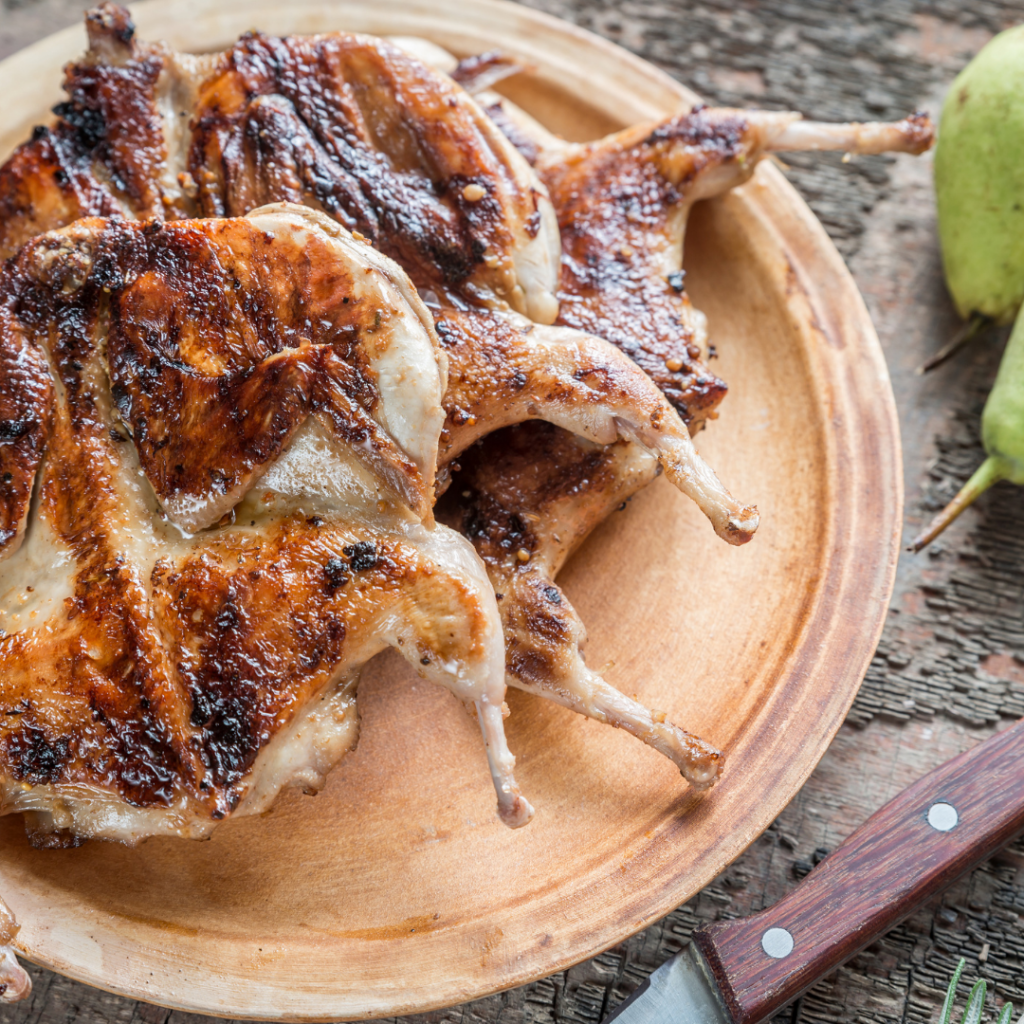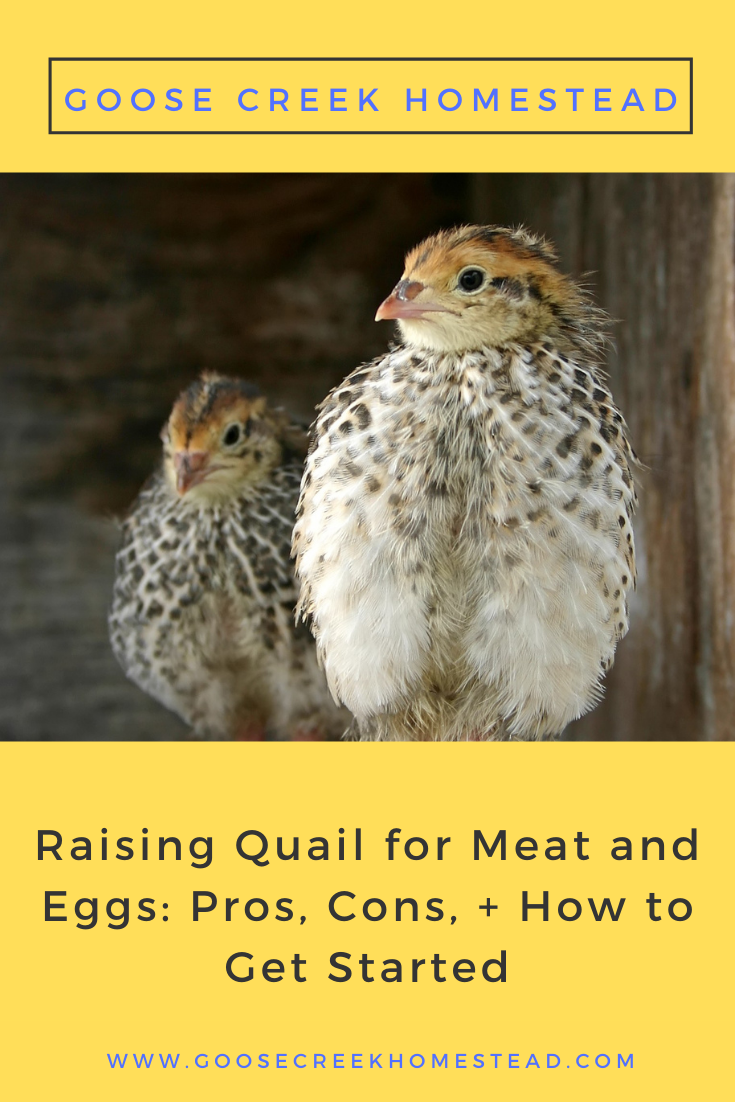Have you considered raising quail to increase self-sufficiency on your homestead? Here are the pros and cons of raising quail for meat and eggs plus a quick guide to getting started.
Would you like to have chickens or ducks on your urban farm, but you’re worried about the noise bothering your neighbors? Or, maybe you just don’t have enough space for larger birds.
It may not even be legal to have poultry if you live within town limits. Or, maybe you simply don’t want to announce your self-sufficiency efforts to the entire neighborhood… believe me, I get it!
When considering poultry for the homestead, people often forget about quail. But these fascinating and productive little creatures can be a great addition to your self-sufficiency efforts, especially on a stealth urban farm or small homestead.
Today, we’re going to take a deep dive into the pros and cons of raising quail for meat and eggs to increase self-sufficiency on the homestead. I’ve also included a quick guide to getting started with quail to help you decide if they’re right for you.
The Pros of Raising Quail for Meat and Eggs
1. Quail are Efficient Meat Producers for Small Spaces

If you want to increase your self-sufficiency by raising your own meat, then you should definitely consider raising quail. Although you won’t get as much meat from a quail as you would a chicken, one or two quail will feed the average adult.
Since quail are small birds, you can raise a lot more of them in the same amount of space. They can be a fantastic meat source for one or two people, or they can supplement other meat sources for larger families.
Quail meat is considered to be a delicacy. I find it to be a bit more flavorful than chicken, as well as more tender and juicy. If you want to try it before you decide to raise your own, look for it at your grocery store or fancy restaurants and expect to pay a premium.
They also mature much faster than chickens so they can be ready to harvest at seven weeks old. On the other hand, meat chickens usually can’t be harvested until they’re 12 weeks old or more.
Once you learn how to manage your space and hatching program for maximum efficiency, you might even be able to harvest as much meat from your quail as you would with chickens. And, you’ll get it faster, too.
2. Quail Lay Delicious Eggs

Almost everybody loves eggs, and they are incredibly versatile. Quail eggs are absolutely delicious for everything from breakfast to baking.
Although the eggs are smaller than chicken or duck eggs, quail are efficient egg layers, and they start laying eggs as early as seven weeks of age. You won’t see eggs from a chicken until she’s about six months old.
If you’re just starting out on your farm or homestead, you could be collecting eggs in less than two months, instead of six. That’s quite a difference!
In my experience, you can expect an egg a day from each mature quail hen for most of the year. Just keep in mind that it takes about three or four quail eggs to replace a chicken egg in a recipe.
But, when you factor in the earlier production and the fact that you can raise so many more quail in the same amount of space, they are certainly worth raising for eggs and meat.
Quail eggs taste pretty much the same as chicken eggs, but they are a little better for you. They contain a bit more protein, healthy fat, vitamins, and minerals than chicken eggs do.
And, quail lay adorable little spotted eggs, so you’ll always have a pretty egg basket.
3. Quail Can Be an Extra Source of Income on the Homestead
It may surprise you to find out there’s a pretty good market for quail. People love them for all the reasons we’re talking about in this post. They’re cost-effective to get into and cost-effective to raise, as well.
Of course, the cost of your starter flock will vary greatly depending on your area, but generally, you can buy a pair of Coturnix quail for less than $10, and hatching eggs or chicks are even cheaper.
Rarer breeds will cost more, but the investment should still be quite small. And, they’ll be more sought after, which will make their resale value a bit higher.
If you wanted to make a little money with your quail, you could breed them and sell hatching eggs, hatchlings, or raise them up and sell breeding pairs.
Of course, if you raise more than you need, you could also sell your extra eggs and extra adult birds, too. You might even explore the possibilities of selling processed quail for meat in your area, depending on local laws.
As I mentioned, some breeds are a little rarer than others, making them more desirable. You’ll want to do your research to see what’s available and in demand in your area before you get into breeding quail to sell.
It’s also important to note that quail are considered game birds. Be sure to inform yourself about any laws regarding breeding and selling quail in your area before you commit.
4. Quail Are More Cost-Effective Than Chickens
Quail are more cost-effective to raise than chickens and other larger types of poultry. They mature so quickly, so you’ll spend less money on food, bedding, and other necessities.
They’ll take up less of your precious time, too. In fact, the daily chores for our large flock only take a few minutes. Of course, you will need to set aside additional time to clean out their coop regularly.
Quail are much easier to process than larger poultry, too. They can be processed in just a few minutes per bird, once you get the hang of it.
Since quail are small birds, they don’t eat nearly as much food as larger birds. In my experience, they aren’t greedy birds either. They usually will only eat what they actually need in a day, which isn’t nearly as much as a chicken.
They don’t require as much space, which makes their housing more affordable to buy or build. On average, quail only need about one square foot of space per adult bird, while chickens who don’t have access to free-range need up to 10.
At the end of the day, when properly managed, quail are very budget-friendly.
5. Quail Hatch Quickly
By now, you’re probably noticing a trend! Quail do everything faster than chickens, and that includes hatching. Some breeds of quail hatch in as little as 15 days! That’s at least a week faster than chickens.
If you let your quail hatch out their own eggs, they will have about 12 per clutch. You could invest in just a half dozen quail and increase your flock size very quickly. This also makes them very productive if you want to use them as a food source.
6. Quail Can Be Raised Almost Anywhere Because They’re Stealthier Than Larger Poultry
Although most towns and cities will have an ordinance preventing you from raising chickens and other poultry in town, quail don’t usually cause a problem.
They’re much quieter, and chances are good your neighbors won’t even know they’re there unless you keep a lot of mature roosters. If you’re looking for stealthy ways to increase your self-sufficiency, quail can be an excellent choice.
You could also raise them in a garage or on your porch if you wanted to. I’ve even heard of people raising them in a spare room right in the house.
Of course, you should always check your local ordinances before you get started, but in general, you’ll find them much more widely accepted than chickens.
 |
Heirloom Organic Seed Bank Collection from Botanical Interests – $54.00
These open-pollinated heirloom varieties have been around for fifty years or longer. Your parents or grandparents may have grown them in their own gardens! Each variety in this collection will typically last 3-5 years if kept cool and dry. A great gift idea for yourself or fellow gardeners who like the peace of mind that comes with having a survival stash of seeds on hand at all times for food security.
|
The Cons of Raising Quail for Meat and Eggs on the Homestead
Now that you know the pros of raising quail on the homestead, let’s dive into the cons so you can make an informed decision.
- Quail chicks are fragile: Be prepared to coddle your quail chicks a lot more than you would chickens or ducks.
- Quail get stressed easily: Quail get stressed easily. If there’s a predator coming around at night or a lot of commotion going on during the day, they may stop laying eggs until things calm down.
- Quail won’t hatch their own eggs: In general, domestic quail won’t go broody and hatch out their own eggs as chickens do. Some breeders do manage to pull it off, but it’s extremely rare.
- Quail roosters can be noisy: Mature quail roosters do crow, so they can get noisy if you keep more than one or two. Although their crow isn’t nearly as loud as a chicken, it’s still something to keep in mind, especially if you’re trying to be stealthy.
- Quail can be stinky: Quail poo can be stinky. You need to be diligent about cleaning out their coops, especially if you’re raising them in an enclosed space.
- Quail are small: While their small size can be a pro, it can also be a con, depending on your situation. You would need a very large flock if you were counting on quail as the sole egg and meat supply for a family– it may not be practical or efficient. I recommend quail as a supplement to other egg and meat sources. If you had a large garden and did a lot of foraging, hunting, and fishing in addition to raising quail, you might be able to make it work.
How to Get Started Raising Quail for Meat and Eggs
1. Decide what type of quail you want to raise.
There are literally hundreds of species of quail throughout the world. The type of quail you decide to raise on your homestead should be determined by their purpose. Here the two most common types of quail raised in the US and what they’re used for.
- Jumbo Coturnix Quail for Meat and Eggs: We raise Jumbo Coturnix quail on our homestead because they’re excellent producers of both meat and eggs. Coturnix quail can be harvested for meat at seven weeks and our birds dress out at about 10-14 ounces per bird. They also start laying eggs at seven weeks. We find that we average about 300 eggs per year from our mature Coturnix quail hens. They don’t have to be separated into breeding pairs, which is a major bonus when you’re short on space. You’ll need one rooster for every six to eight hens in each breeding group. Coturnix quail that have been specially bred to lay blue eggs may have a higher resale value in your area, so you might want to check into that if you’re looking to make some extra money with your quail.
- Bobwhite Quail: Bobwhite quail are native to the US. They are a bit smaller than Coturnix and generally yield about 6-8 ounces of meat per bird. Their eggs are a bit smaller, too. Raising bobwhite quail for eggs is quite popular, but keep in mind that you may need four or five bobwhite eggs to replace each chicken egg in a recipe. They also need more space than Coturnix, and most breeders recommend separating them into breeding pairs, rather than keeping them in flocks. That said, they are very pretty little birds and if there’s a demand for them in your area, they’re certainly worth considering.
2. Prepare for Your Quail.
Always prepare appropriate housing for new livestock before you make a purchase! Bringing home animals without a safe place to put them is a huge mistake, and it’s one of the reasons new homesteaders get overwhelmed.
-
-
- Incubator: If you decide to start out with hatching eggs, you’ll need an incubator with a tray that’s small enough to accommodate quail eggs. If you are serious about raising quail for self-sufficiency, I highly recommend investing in a quality incubator right from the start. You might be able to save money in other areas, such as repurposed housing, by a good incubator is key for success. To raise quail for meat, you will also need an incubator that’s large enough to hatch out the number of meat birds you want to raise each cycle. The incubator I use comes with a universal try that allows me to hatch 41 quail eggs at once and it’s perfect for our needs. (I use it to hatch chicken and duck eggs too. It’s an indispensable piece of equipment on our farm and well worth the investment.)
- Brooder: If you’ll be hatching eggs or purchasing quail chicks, you’ll need to set up a brooder for them. Keep in mind that quail chicks are tiny and they are extremely fragile for the first week or two. Our brooder setup is a large Rubbermaid tote with a window cut in the top and covered with a screen. We provide a heat plate that gives the chicks a warm area at about 95 degrees for the first week. Once a week, as your chicks grow, raise the hotplate to give them more room and prevent overheating. The openings on your feeder and waterer must be very small for quail chicks. Allow about 1 square foot of space for every four chicks. We feed our quail chicks gamebird starter/grower crumbles (chick starter does not have enough protein for quail.) Your chicks are ready to go to their regular housing when they’re fully feathered, usually at about three or four weeks. If it’s cold outside, we keep them in the brooder a week or two longer.
-
- Housing for Juvenile and Mature Birds: If you’re raising quail for meat and eggs, you’ll need separate housing for your breeders and juvenile meat birds. We have a couple of two-story rabbit hutches like this one and keep them in our carport. Raising quail in rabbit hutches can also work well on a covered porch, in a garage, or even a spare bedroom. You can certainly build your own quail hutches, but be sure to keep the ceiling low. Quail startle easily and will jump up and break their necks when they hit the ceiling if they catch too much air on the way up. Some people raise their quail in mobile coops on grass, but be sure the pens are predator proof because everything from snakes, large rodents and varmints, to domestic dogs and cats will want to eat them. Mature birds should have one square foot of space per bird. We continue to feed our grow outs game bird starter/grower until harvest time. Any birds you’ll be keeping as breeding stock can be transitioned to Gamebird Chow at around 7 or 8 weeks old. Quail are timid birds, so be sure to provide little brush piles or overturned containers for them to hide under. They will stop laying eggs if they feel stressed.
3. Buy Your Hatching Eggs, Chicks, or Birds.
Basically, you have three options when it comes to getting started with quail. You can purchase fertile eggs and hatch them yourself, you can purchase chicks, or you can start with juvenile or mature birds. Here are the pros and cons of each option.
-
- Fertile hatching eggs: We started our quail flock with mail order fertile hatching eggs from a reputable breeder on Amazon because there were no chicks or mature birds available in our area. This option ended up working out very well for us because we were able to start with a dozen eggs for about $20 plus shipping. Once the eggs hatched, we raised the chicks, harvested the extra roosters, and continued hatching out more eggs until we had a flock big enough to supplement our eggs and meat supply for our family of three. Hatching eggs can be tricky because the conditions have to be just right, so be sure to follow the instructions on your incubator carefully.
- Chicks: Purchasing chicks from a mail-order hatchery or local breeder is another option. Keep in mind that most mail-order hatcheries will require you to purchase 50 chicks or more to help them stay warm during shipping. If you can find a local breeder selling the breed of chicks you want, it might be a better option. Quail chicks are very fragile, so shipping can be tough on them and you’ll probably end up with some losses during shipment.
- Buying Birds: If you’re in a hurry for eggs, buying juvenile or mature birds will be the fastest way to get there. However, you will be limited to whatever birds are available in your area, so you may not have as many choices. You’ll also get fewer birds for your money, but the price should still be quite reasonable.
How many quail does a family need for meat and eggs?
The best way to decide how many quail your family needs to raise for meat and eggs is to decide how many times a week you want to eat quail. You’ll need two quail per adult and one quail per child per meal on average.
So, our family of three eats quail once a week and we prepare five or six quail at each meal, depending on their size. That means we need to hatch out at least 27 birds per month for meat.
Of course, you’ll probably never have a 100% hatch rate. We usually put about 40 eggs in the incubator each month. We save them up until we have enough (up to 7 days) then put them in the incubator all at once. Most of the time, we end up with a few extra chicks that can be sold or grown out and processed as extra meat for the freezer.
So, for us two breeding groups of six to eight hens and one rooster works out perfectly. That gives us enough eggs for hatching plus plenty of extra eggs for eating during the rest of the month. We could probably get by with just one breeding group, but I like to err on the side of having too much rather than not enough. In fact, we store enough equipment and starter/grower that we could double or triple our meat production very quickly, should the need ever arise. You just never know what life is going to throw at you!
I should also mention that we practice selective breeding for the most productive quail flock possible. Every 3-6 months (whenever I start to see production slowing down), I let the grow outs mature until they’re about 9 weeks old. Then, I keep the biggest birds as breeders. The older, less productive birds are processed as stewing birds.
Raining Quail for Meat and Eggs-Additional Resources to Help You Get Started
Want to learn more about raising quail for meat and eggs on your homestead? Here are some additional resources that I have found extremely helpful along the way!
Urban Quail Keeping
Urban Quail Keeping is an excellent guide for all quail keepers with a focus on raising quail for meat and eggs in urban areas. It’s one of the best raising quail books I’ve found and I highly recommend reading it before you bring home your first quail.
Storey’s Guide to Raising Poultry
Storey’s Guide to Raising Poultry is one of the first books I bought when we started our homestead. Although the section specific to quail is pretty small, this book is full of valuable information that will be helpful no matter what kind of poultry you decide to raise. It’s great to have on hand for easy reference and it will help you compare the pros and cons of other types of poultry in case you’re still undecided about what you want to raise.
YouTube
YouTube can be a wealth of information, both good and bad. Here are two channels that I recommend for reliable information on raising quail for self-sufficiency.
- Living Traditions Homestead: Kevin and Sarah at Living Traditions Homestead Have several excellent videos about raising quail. If you go to their channel page and do a search for “quail,” it’s easy to find them all. This channel is full of tons of valuable information about raising meat rabbits, gardening, and self-sufficiency in general. Honestly, it’s probably my favorite homesteading channel on YouTube.
- Self-Sufficient Me: Another fantastic channel with tons of reliable and useful information about raising quail. I’ve linked directly to his quail playlist here, but I urge you to check out his other videos on everything from raising other types of poultry to growing a ton of food in small spaces.
So, Is Raising Quail Worth It?
I think so! If you’re an urban farmer or small homesteader looking to improve your self-sufficiency by raising some of your own meat and eggs- or you want to make a little side money in a small amount of space- quail are a viable option worth considering.
Don’t get me wrong, I love my ducks, turkeys, and chickens, and they will always have a place on my homestead. But we’ll probably always have quail, too.
















